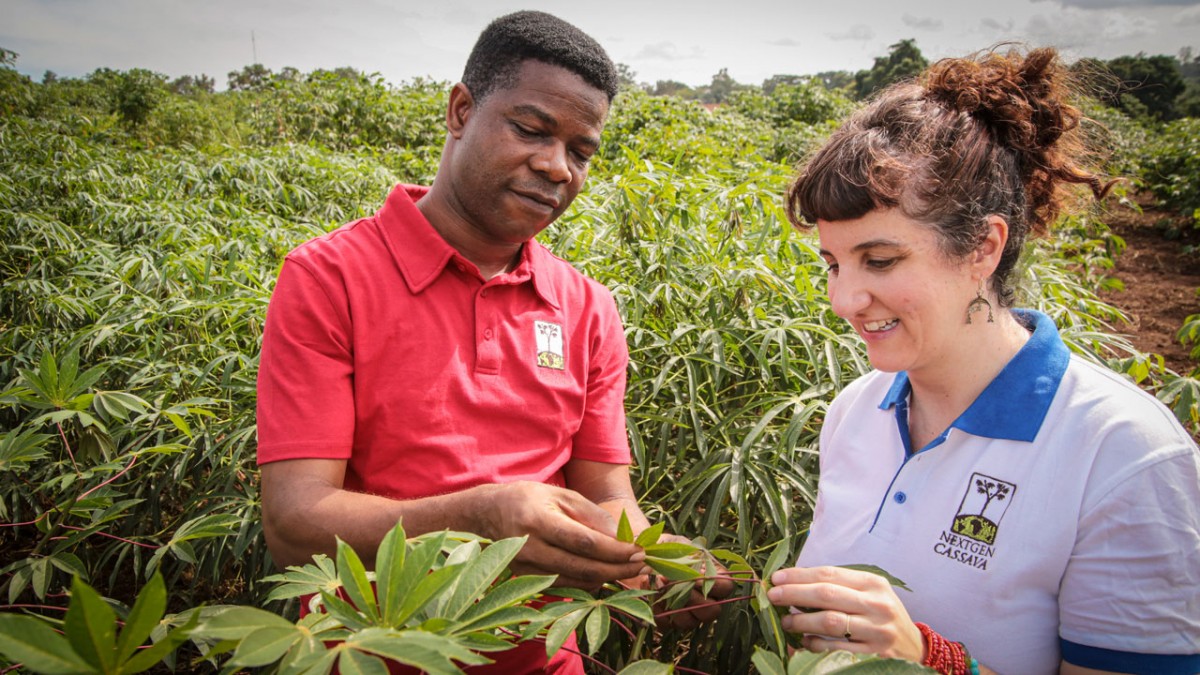
Hale Ann Tufan, right, inspects a cassava plant with Chiedozie Egesi, program director for the NextGen Cassava project, during a visit to research fields in Namulonge, Uganda. Credit: NextGen Cassava.
New crop varieties can help farmers thrive in difficult agricultural conditions, feed families and create livelihoods when sold or processed into other products. This creates a design challenge for breeders, who must anticipate which traits are needed for a variety to be adopted and have a positive impact for smallholder farmers and consumers.
Hale Ann Tufan (Cornell University) is one of a group of researchers looking to solve this problem using gender-responsive tools and data. These can provide deep insight into the needs of different users in the value chain - including women farmers, consumers and food processors.
In Tufan's words, the goal of this work with the NextGen Cassava project is "to identify actionable breeding targets that meet diversity and demand", working through a three-step approach with smallholder farmers in Nigeria, Tanzania and Uganda.
Tufan described this work in depth at the EiB Virtual Meeting 2020
The first step is to use qualitative research tools to capture how producers, processors, consumers and traders describe the characteristics of high-quality food products, in their own words. Information is also collected on why these characteristics are important. Respondents are deliberately and inclusively selected to reflect the diverse social makeup of a community.
The second is to use the 1000minds software, which asks farmers to rate traits against each other according to their preferences, leading to trait typologies and economic values. Analysis of the 1000minds data is used to identify different groups, or typologies, of people based on their preference for different crop characteristics. These data are then related to social demographic and household data collected with the RHOMIS tool, to explore relationships between typologies and social identities, poverty levels and household food security status.
The third is to test if these preferences/choices hold true in the field, using the TRICOT (on-farm triadic comparisons of technologies) technique to track if choices around varieties grown by the same respondents under different field conditions follows the typologies generated in step 2.The TRICOT data is also used to identify which traits are ultimately crucial for breeders to target.
The key innovation by NextGen Cassava is to add food security and poverty data from household surveys, and to apply the 1000minds tool to husbands and wives separately and then together in a joint interview to explore intrahousehold dynamics and choices around trait preferences. The work included critical findings from the RTBfoods project, which helped define characteristics, especially on processing and food product quality.
Looking at the 1000 minds data, three main typology groups were identified among ~800 farmers: those that appreciated cassava varieties that survived better in the field, those that looked for quality traits such as color or taste, and those focused on the output in terms of yield, root size or maturity time.
While research is ongoing, early results identified that the quality typology of farmers tended to be female and have better food security, whereas those focused on crop survivability were more affected by poverty.
According to Tufan, these results have potential to provide empirical data to support the assumptions made by breeders when setting breeding priorities. "As women make more decisions or have higher access to assets, it seems they prioritize quality," added Tufan.
The challenge over the next year is to explore how much insight can be found by crossing the various datasets, how breeders can incorporate such approaches in their work and how the benefits of doing so are balanced against the costs.
The CGIAR Excellence in Breeding Platform (EiB) is promoting the use of product profiles – written descriptions of the varieties that breeding programs aim to produce that have the right mix of qualities to become successful. EiB is supporting the application of 1000minds in Uganda under the NextGen Cassava Project.
To incorporate gender-responsive traits and tests into these product profiles, EiB is also working with the Gender & Breeding Initiative (GBI) to pilot new tools for breeders. Five pilots of these tools are being conducted in Nigeria, Morocco, Uganda and Zimbabwe, including two supported by EiB and two supported the CGIAR Research Program on Roots, Tubers & Bananas (RTB).
Comments
If not for the stem color,